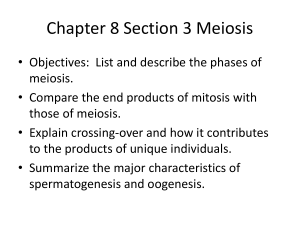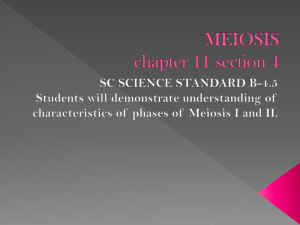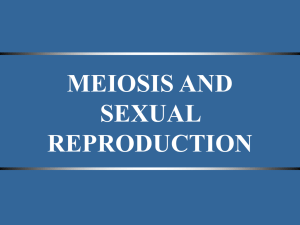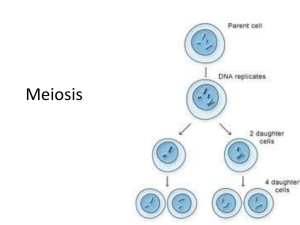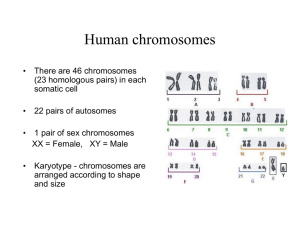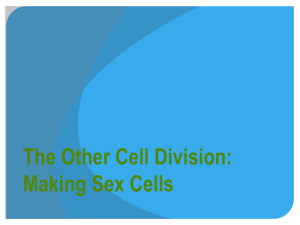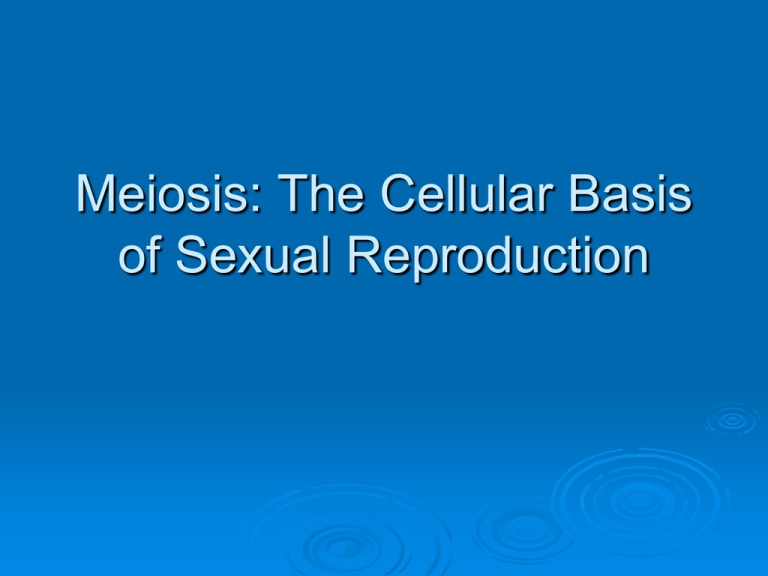
Meiosis: The Cellular Basis
of Sexual Reproduction
The Mechanisms of Meiosis
Meiosis
is based on the interactions and
distribution of homologous chromosome
pairs
Meiosis
produces four genetically different
cells with half the parental chromosomes
Sexual Reproduction
Sexual
reproduction produces offspring by
union of male and female gametes (sperm
and egg)
Meiosis produces gametes with half
chromosome number
Evolutionary advantage: Genetic shuffling of
sex
Fertilization
Fertilization
fuses nuclei of egg and sperm
Zygote cell produced by fertilization
Restores parental chromosome number
Homologous Chromosome
Pairs
Paternal
chromosomes from male parent,
maternal from female parent
Homologous chromosome pairs
Alleles may be different within homologous
pairs
Meiosis
separates homologous pairs
Before meiosis, diploid (2n)
After meiosis, haploid (n)
Diploid
Haploid
Meiotic Cell Cycle
Mitosis
and meiosis compared
Both: Similar cell divisions, meiosis divides
twice
Mitosis: Two identical daughter cells, diploid
Meiosis: Four genetically different cells,
haploid
Premeiotic
interphases similar to mitotic
interphase
Chromosomes copied into sister chromatids
Meiosis I
Meiosis
I: First meiotic division
Recombination exchanges segments between
homologues
Produces two haploid cells with chromatids
attached
Meiosis II
Meiosis
II: Second meiotic division
Sister chromatids separate into separate cells
Produces 4 recombined haploid cells
Meiotic Divisions
Homologous
chromosome pair
A diploid cell showing
the two chromosomes
of a homologous pair.
Replication during
premeiotic interphase
Sister chromatids
As a result of replication,
each chromosome consists
of two sister chromatids.
Chromosome pairing during
prophase I of meiosis
Fig. 11-2a, p. 223
While the homologous
chromosomes are paired,
they may undergo recombination
by exchanging segments.
First meiotic
division
Second meiotic
division
The first meiotic division
separates the homologs,
placing one in each of the
two cells resulting from the
division. These products
have the haploid number of
chromosomes, but each
chromosome still consists
of two chromatids.
The second meiotic
division separates the
sister chromatids,
placing one in each
cell resulting from the
division.
Fig. 11-2b, p. 223
Meiosis
animation
Meiotic Cell Cycle
Prophase
I
Sister chromatids condense to chromosomes
Synapsis (pairing of homologs)
Tetrads (Fully paired homologs)
Recombination mixes alleles across tetrads
Prometaphase
I
Nuclear envelope breaks down
Kinetochores attach to polar spindles
Meiotic Divisions
Meiotic Cell Cycle
Metaphase
Tetrads align on metaphase plate
Homologs segregate, move to poles (sister
chromatids attached)
Nondisjunction creates abnormal
chromosome numbers
Telophase
I and Anaphase
I and Interkinesis
No change in chromosomes
Spindle disassembles
Meiotic Divisions
Meiotic Cell Cycle
Prophase
II, Prometaphase II, and
Metaphase II
Chromosomes condense, spindles form
Nuclear envelope breaks, kinetochores form
Chromosomes align on metaphase plate
Anaphase
II and Telophase II
Spindles separate chromatids
Spindles disassemble
New nuclear envelopes form
Meiotic Divisions
Meiotic Divisions
Comparison of Meiosis and
Mitosis
Comparison of Meiosis and
Mitosis
Sex Chromosomes in Meiosis
Sex
chromosomes
Different in males and females
Human females XX, males XY
XX fully homologous, XY homologous in short
region
Sex Chromosomes in Meiosis
Meiosis
and sex chromosome inheritance
Gametes produced by females may receive
either X chromosome
Gametes produce by males may receive
either X or Y chromosome
Sex determination
Sex
– sexual phenotype
Male and female
determination – mechanism by which
sex is established
Sex
Mechanisms That Generate
Variability
Recombination
depends on physical
exchanges between homologous
chromatids
Segregation of maternal and paternal
chromosomes is random
Random joining of male and female
gametes in fertilization adds additional
variability
Recombination of
Chromatids
Recombination
(crossing over)
Key genetic shuffle of prophase I
Tetrads
held together at synaptonemal
complex
Two of four chromatids exchange alleles
Chiasmata or crossovers are points of
exchange
Crossing Over
Prophase I
Long
and complex
Pachytene = Synaptonemal complex
Elaborate protein structure
Crossing over occurs – homologous
chromosomes exchange genetic information
Synaptonemal Complex
Random Segregation
Random
segregation
Key genetic shuffle of metaphase I
Each
chromosome of a homologous pair
may randomly end up at either spindle
pole
Any combination of maternal and paternal
chromosomes can be segregated to gametes
2X number of possible combinations
Genetic Variation
Independent
segregation of homologous
pairs of chromosomes
23 pairs of chromosomes
223 or >8X106 different combinations
Random Spindle Connections
Random Fertilization
Random
chance of male and female
gamete forming zygote
Meiosis
allows randomness necessary for
Mendelian laws of inheritance
Recombination, random segregation, and
random fertilization are mechanisms of
randomness
Gamete Diversity
animation
Meiosis in humans
Difference
between male and female are
remarkably different
Meiosis in humans
Spermatogenesis
Production of sperm from primordial germ
cells
Begins
at puberty
Each day more than 100 million sperm are
made in each human testicle
Over a lifetime a male produces 1012 -1013
sperm
(Stem cells capable of self renewal)
Developmental Biology, 6th Ed.,
Gilbert
Developmental Biology, 6th Ed.,
Gilbert
Motile nucleus
Meiosis in humans
Oogenesis
Production of eggs from primordial germ cells
Human
embryo by 7 months gestation, 7
million germ cells
After 7 months gestation, most germ cells
die, the remaining oogonia enter the first
meiotic division
Meiosis in humans
Primary
oocytes, progress through the first
meiotic prophase until the diplotene stage,
at which point they are maintained until
puberty (~12 years later)
Of the millions of primary oocytes present
at birth only about 400 mature during a
women’s lifetime
With the onset of adolescence,
groups of oocytes periodically resume meiosis
Meiosis in humans
Oogenic meiosis also differs from spermatogenic
meiosis in its placement of the metaphase plate.
At telophase, one of the two daughter cells
contains hardly any cytoplasm, whereas the
other cell has nearly the entire volume of cellular
constituents
The smaller cell is called the first polar body,
and the larger cell is referred to as the
secondary oocyte.
Meiosis in humans
During
the second division of meiosis, a
similar unequal cytokinesis takes place
Most of the cytoplasm is retained by the
mature egg (ovum), and a second polar
body receives little more than a haploid
nucleus.
Thus, oogenic meiosis conserves the
volume of oocyte cytoplasm in a single cell
rather than splitting it equally among four
progeny
Developmental Biology, 6th Ed.,
Gilbert
New Information
Research
suggests women can make new
eggs throughout their lives
What defects might occur if
there are errors in meiosis?
Question
80-90%
of abnormalities in chromosome
number result from nondisjunction at
maternal Meiosis I
Why might this be more common in female
gametogenesis than male gametogenesis?
Mistakes in Meiosis
animation
Explain to your neighbor how you will tell
the difference between these phases
Metaphase
of mitosis and metaphase I of
meiosis
Metaphase of mitosis and metaphase II of
meiosis
Metaphase I and metaphase II of meiosis
Telophase of mitosis and telophase of
meiosis

